Maybe you are asking yourself some questions about underwater scooter diving like:
What is an underwater scooter? Which are the best underwater scooter models? What should I do to dive with an underwater scooter? These and other questions we will be answering with the information below.
In this article we want to give you a precise overview of what the experience of underwater diving with an underwater thruster means, which can take you to a more exciting level in your diving practice.
Here we will tell you about underwater thrusters, also what you do or do need to know to dive with this device, about its design and handling at the time of diving and other information that could be answering your questions about this unique diving activity.
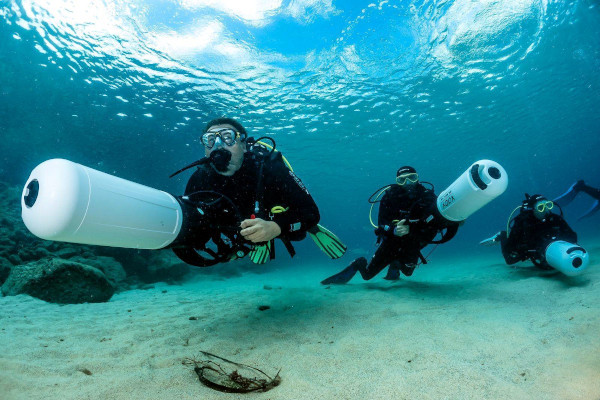
An underwater scooter or Scooter for diving, also called DPV for its acronym in English, (Diver Propulsion Vehicle) is a device that makes the experience of diving a much more rewarding experience, offering you a number of new possibilities.
The advancement of technology and its innovations constantly introduces new ways of diving, giving us facilities and new experiences through the devices and their functions.
DPVs or underwater scooters can be used also for recreational diving and not just for professional diving.
These are designed so that components such as the propeller have no chance of endangering the diver or damaging other equipment.
It is also very important to know that the scooter has a secure system against accidental activation or starting.
Here is everything you need to know about diving with an underwater scooter:
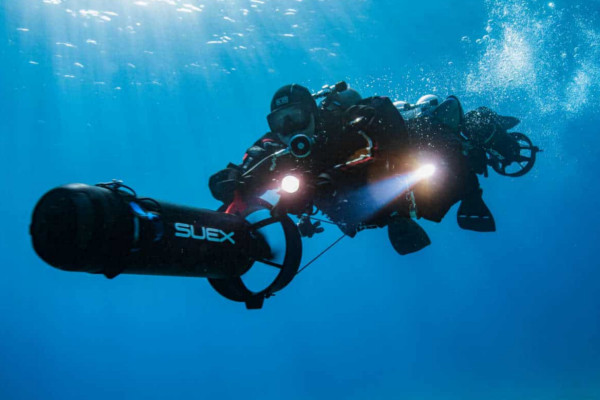
What is a DPV?
DPV (Diver Propulsion Vehicle) or propulsion system for diving, is a device that is basically made up of two elements: a motor and a propeller, which are contained within a chassis.
The traditional model has two side handles on which the diver holds onto and which also allow the scooter to be directed
Other terms related to DPV and their acronyms in English are as it follows
- (ROV) Under Water Inspection Camera
- SDV) Swimmer Delivery Vehicle
- (AUV) Autonomous Underwather Vehicle
It shouldn’t surprise you that there are different types of DPVs, which can vary in capacity and size, and therefore also varies in price.
The best well known is the cylindrical type, which the diver holds by the sides, and which comes with basic start button, that allows the user to move freely.
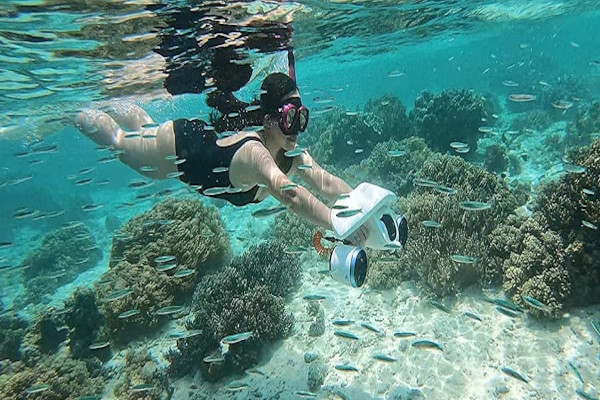
The way the DPVs are built helps the scooter not to injure the person who is managing to ride it, or any other surrounding equipment.
One of the most important characteristics of this type of devices is that it is designed not to accidentally turn on.
What are the advantages of underwater thruster diving?
There are many advantages that can be mentioned about using an underwater scooter for diving.
One of these advantages is that allows the diver to go faster and reach more distant places. Places that would probably be impossible to reach moving only with the fins.
The speed and reach of underwater scooters have revealed a whole new and exciting world for professional divers and new divers.
It is also attractive for those divers who love to experience strong emotions by raising their adrenaline level due to the sensation of moving at high speed underwater.
Brief history of underwater scooters
The use of the DPVs at first was for military purposes. DPVs applications dates back to World War II, where some
similar to those used today were manufactured.
Torpedo parts were used to make the first models of underwater scooters. Currently in military or armed forces
environments, they are been called (SDV), Swimmer Delivery Vehicle
Who can dive with a DPV?
Underwater scooters were used in the past almost exclusively by specialized divers with a technical profile, for
their explorations, in order to explorer remote places.
Nowadays DPVs are available for divers over the age of 12, and who have at least a PADI Open Water certificationor a similar degree.
If you want to try diving with an underwater scooter, you must have basic diving skills.
A good recommendation to start using an underwater scooter is that the person has had at least twenty-five dives before
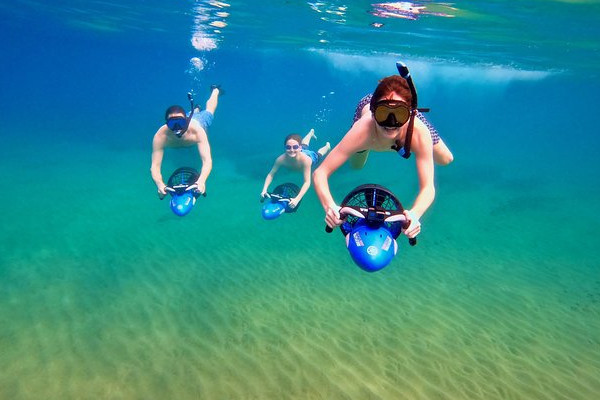
First time diving with a DPV
The first thing you should do to know if diving with an underwater scooter is your thing, is to take a test dive
accompanied by an instructor. Once you have tried, you will see how thruster diving works, and how different it is
from traditional diving.
Most likely, after the test dive, you will undoubtedly want to repeat the experience. Participating in a scooter
diving course will then be the most recommended advice.
The three most important things you will learn in the DPV course are:
- General function of underwater scooter
- How to operate a DPV
- The best way to plan a dive with underwater scooter
Once you have completed the course, you will receive a certificate with which you can access to rent or operate an underwater scooter anywhere on the planet.
How is like a DPV course?
The underwater scooter DPV course is a lot of fun
Using these devices for diving is an experience like very few in life. It is an activity that generates a lot of adrenaline and satisfaction, all at the same time.
In this course you will learn basic concepts of how DPV are built. You will also learn what steps to take before using them, and something called prior diving.
Also, of course, you will learn the diving itself.
But above all, the most important thing about the course is that you will learn basic safety concepts. Concepts that will give you the confidence as you learn and apply all the rules of diving with DPV.
DPV diving without an instructor?
It is easy these days to get an underwater scooter , either to purchase or to rent. Anyone can access the different models of DPV and try to learn by themselves. However, it is highly recommended not to!
Using DPVs scooters can be extremely dangerous if used without a proper prior training.
Taking the scooter to the surface at high speed by mistake may cause injury to the user.
It is highly important to go at a moderate speed especially when surfacing.
That is only one reason why it is important to be well prepared when using a diving scooter.
Diving in caves with underwater scooter
When we think of diving in caves with a DPV the first thing to take into account is safety.
Cave diving can be both rewarding and dangerous at the same time.
Especially when this experience is exploration, a longer route inside the caves is planned and additionally heavier equipment is available.
Which case requires a thorough knowledge of gas management and contingency planning in the use of the DPV.
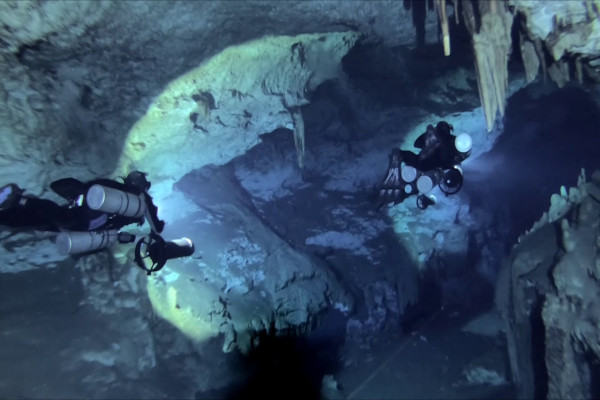
It is believed that most part of earth surface are not just flat land or elevations, but there are also a large number of caverns and caves, whose exploration may cause a mixture of excitement and risk.
When using an underwater scooter for cave exploration diving, it is imperative to master the basics of maneuvering very well. Otherwise, you could hurt yourself or other divers.
It is not recommended to speed up too much at the time of the ascent.
Another important recommendation is to always check the computer and to make sure that the speed is not excessive when ascending.
The appliance must be verified to be in good condition before being used.
If for some reason water enters the internal part of the equipment, due to some damage or failure, this could be very expensive.
How can DPVs be classified?
Underwater scooters can be classified into two groups:
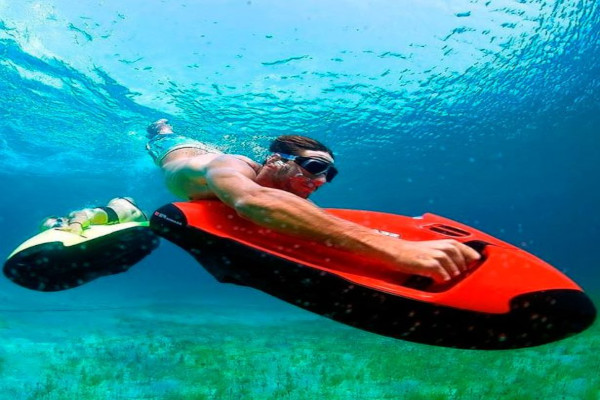
Underwater scooter for amateurs
Generally, this type of scooter has a plastic casing which contains all the electronic equipment inside.
The average price of a plastic casing underwater scooter don´t usually exceed some hundreds of dollars.
Most of the time these models do not come with multiple speed, but instead they have an on / off switch. (Running and braking). It means that they are single speed.
It is the recommended equipment for those who start diving with scooters.
Look also: Technical diving, everything you need to know to become a technical diver
Underwater scooter for professionals
Professional underwater scooters generally have an aluminum shell and may have various speeds.
There batteries generally last longer and the scooter can be operated with one hand. Although, the price can go beyond a thousand dollars.
The average speed of almost all underwater scooters is between 4 and 7 km.
They are highly beneficial for professional divers, allowing them to expend less energy moving and giving maximum performance in executing their dive plan.
The Best Aquatic Scooters of 2022
By mentioning the different brands below, it would be good for you to see their characteristics later and consider which would be the most suitable model for you.
Generally, those that have two thrusters are more stable than those that only have one, which is why they are more recommended for beginners.
For their part, those with a single propeller offer greater maneuverability and freedom of movement.
These are the most important underwater Scooter models of 2022
- Yamaha Seal Sea Scooter
- Yamaha, RDS300 DPV – Sea Scooter
- Scooter Acuático Yamaha 500
- SeaDoo GTI
- Scooter Submarino S1 LEFEET
- DPV Eléctrico Whites Hark Mix
- Scooter Acuático Bixpy Swim Jet
- Magic Jet Subatwet Scooter.
Diving scooter uses
- TECHNICAL
- PROFESSIONAL
- MILITARY
- SEARCH
- RESCUE
How to choose the best DPV
In order to choose the best underwater scooter, it is important to first define the type of usage you will give to it.
For example, if you are going to use it to explore places away from the coast, a favorite place or for technical or
cave diving, you will probably be going to need a more powerful equipment.

If your goal is only to take a look at moderate depth, then a not too expensive equipment would be appropriate
enough. Here we give you a few import things to take into account
Máximum Depth of Reach
How deep you want to use the DPV will be related to the quality of the machine to be purchased.
If the idea is to use it at a depth of 5 meters you won’t necessarily need to acquire a very high price equipment.
This type of equipment generally consists of a plastic casing and its cost would be around a few hundred dollars.
For deeper dives, higher standards are required.
Battery Power and Duration
The batteries of the underwater scooters can vary in their power, and some of the batteries might last long depending on if the scooter have or not variable speed.
Those underwater scooters that uses lithium battery have a higher durability.
As we said before, you should always consider the use that you are going to give to it.
It is very important to take into account the practicality of removing and inserting the battery when it is depleted and replacement must be done.
The propellant must have its energy indicator to prevent risks.
It is recommended that the battery has a minimum runtime of at least 30 minutes. What you want to avoid is running out of batteries at a great distance from the coast.
Buoyancy
Another important aspect you should take into account when choosing an underwater scooter, is buoyancy control. When you dive it should be
taken into account what you are wearing and its weight, or, what you are carrying with you. Those things will
directly affect buoyancy. The same idea applies for the underwater scooter and the relation between its buoyancy
and its weight
The more buoyant the underwater scooter is, the more effort it must make to keep moving at the desired depth.
Almost all DPVs have means of controlling buoyancy. If not, you will need to adjust to his own weight.
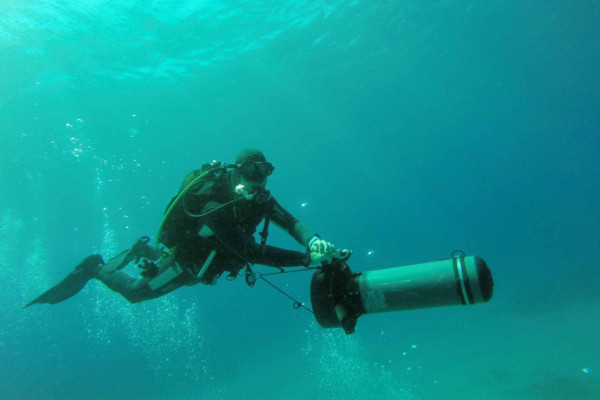
Weight
The weight of the underwater scooter is very important, because you will normally have to carry it on land to the place where it is to be submerged, along with all other diving equipment. This makes it important to choose a model of moderate weight, in order to facilitate transport.
Price
When you choose the price of your underwater scooter, safety is very important.
It is not recommended to acquire a device that is too cheap and take the risk of running out of battery too quickly,
with which it may have some kind of damage under water.
Do not use a DPV at a depth for which it is not recommended.
On the other hand, to use the DVP for recreational purposes only, you may not need to invest in a very expensive
model.
Remember that your safety is directly related to the quality of the equipment you will use.
Summary
Underwater scooters or DPVs make the traditional diving even a much more enjoyable experience.
It is not necessary to be a professional diver if you want to try an underwater scooter, but it is highly recommended to take the previous training course before diving with them.
There are many models of underwater scooters from where you can choose, althouth always you must consider what use and scope you want to give it, in order to take care of your safety.
